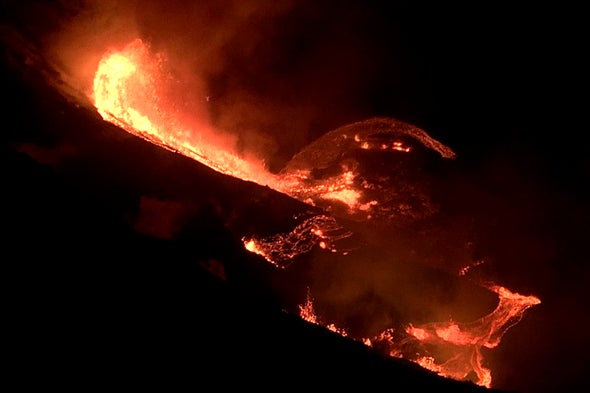
Hawaii's Kilauea volcano erupted beginning Sunday (Dec. 20) night local time, with dramatic lava fountains and huge puffs of gas and steam being launched from the summit crater called Halemaʻumaʻu, the Hawaii Volcano Observatory (HVO), part of the U.S. Geological Survey (USGS), reported.
Though the shield volcano is one of Earth's most active volcanoes, constantly spewing lava from its fissures, the recent eruption is much more dramatic than the "background" streams of lava that consistently flow from volcanic cracks.
"For the past several weeks, the USGS Hawaiian Volcano Observatory has recorded ground deformation and earthquake rates at Kilauea Volcano's summit and upper East Rift Zone that have exceeded background levels," since a 2018 eruption, the observatory said in a statement Sunday.
Video from W rim of the caldera just before midnight. As of December 21 at 1:30 a.m. HST, the growing lava lake has almost reached the level of the lowest down-dropped block that formed during the 2018 collapse events. Over the past 2 hours, the lake has risen by ~10 m (32 ft). pic.twitter.com/Qbx1d6hbq4
— USGS Volcanoes�� (@USGSVolcanoes) December 21, 2020
Just after 9:30 p.m. HST (2:30 a.m. EST, 7:30 a.m. UTC), the volcano observatory picked up a glow in the crater at Kilauea's summit, just before the eruption began. Several fissures opened up in the walls of the crater, which was filled with water; sizzling lava poured through the cracks and into the lake, causing the water to boil away as it was replaced with the molten rock. The crater's northern fissure sent out a huge lava fountain, extending some 165 feet (50 meters) high, the HVO reported.
About an hour later, at 10:36 p.m. HST (3:36 a.m. EST, 8:36 a.m. UTC), a 4.4-magnitude earthquake shook the ground beneath the volcano's south flank. The center of the earthquake was about 4 miles (6 kilometers) deep and about 8.7 miles (14 km) south of Fern Forest, inside Hawaii Volcanoes National Park. More than 30 earthquakes of magnitude-4 or greater have shook Kilauea's south flank in the past 20 years, according to HVO, with most of them caused by the abrupt movement of the south flank as it moves southeast over the oceanic crust.
"HVO continues to monitor Kīlauea as the situation is rapidly evolving with this evening's eruption at the summit of Kīlauea," David Phillips, HVO's acting scientist-in-charge, said in the statement.
The last dramatic eruption occurred in the spring of 2018 when the floor of the Pu'u 'Ō'ō's crater, on the eastern side of the volcano's rift zone, collapsed on April 30, pushing magma underground southeast, Live Science reported at the time. On May 3, a magnitude-5.0 earthquake struck the Big Island near the Pu'u 'Ō'ō crater. That shaking sent lava racing into residential subdivisions in the Puna district of the Big Island. Mandatory evacuations of the Leilani Estates and Lanipuna Gardens subdivisions followed.
Copyright 2020 LiveScience.com, a Future company. All rights reserved. This material may not be published, broadcast, rewritten or redistributed.
"with" - Google News
December 22, 2020 at 12:30AM
https://ift.tt/2KHQzGG
Hawaii's Kilauea Volcano Erupts with Dramatic Lava Fountains - Scientific American
"with" - Google News
https://ift.tt/3d5QSDO
https://ift.tt/2ycZSIP
Bagikan Berita Ini















0 Response to "Hawaii's Kilauea Volcano Erupts with Dramatic Lava Fountains - Scientific American"
Post a Comment